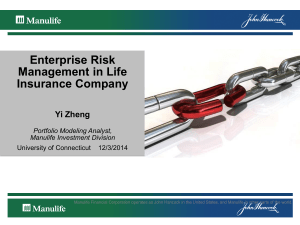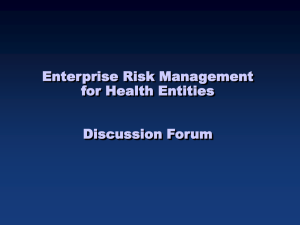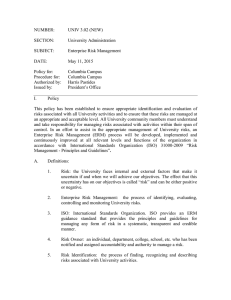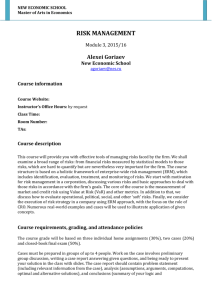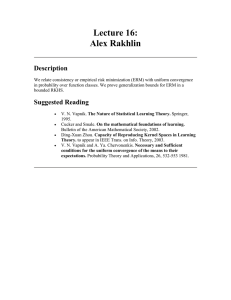Enterprise Risk Management Discussion Document July 30, 2003 “Meeting objectives, with consistency”
advertisement
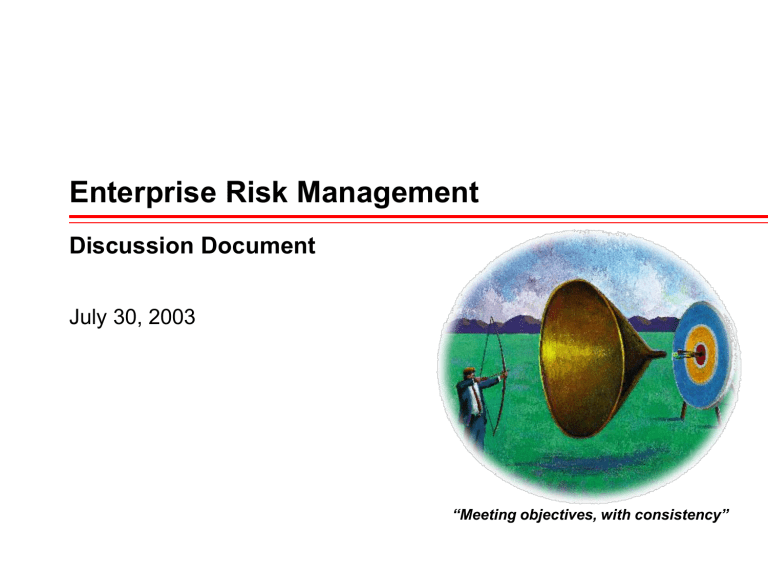
Enterprise Risk Management Discussion Document July 30, 2003 “Meeting objectives, with consistency” Perspective on ERM Conceptual framework ERM issues in the health industry Overview of methodology and process Turning risk to advantage ERM conceptual framework What is Enterprise Risk Management? ERM is a rigorous approach to assessing and addressing the risks from all sources that: Threaten the achievement of key enterprise objectives (I.e., financial, market penetration, customer service) Present opportunities to exploit for competitive advantage Objective: Enhance enterprise value by... Improving capital efficiency Providing an objective basis for allocating resources Reducing expenditures on immaterial risks Exploiting natural hedges and portfolio effects Supporting strategic decision-making Uncovering areas of high potential adverse impact on the drivers of stakeholder value Identifying and exploiting areas of “risk-based advantage” Building enterprise-owner confidence Establishing a process to help stabilize results Demonstrating proactive risk stewardship Minimizing earnings volatility has a significant impact on enterprise value 12 10 8 6 4 2 0 4.48 1.43 Market Value Added High Return Companies Market Value Added The effect of earnings volatility can be seen clearly by first stratifying the industry according to return and growth, thereby normalizing those effects 12 10 8 6 6 4 2 0 3.62 1.39 High Low Earnings Volatility Market Value Added Market Value Added Low Return Companies 10 8 6.26 4 2 0 High Low Earnings Volatility 12 10.14 12 10 8 6 4.90 5.94 4 2 0 High Low Earnings Volatility High Low Earnings Volatility Low Earnings Growth Companies High Earnings Growth Companies Source: Tillinghast – Towers Perrin analysis of 1989-1998 performance of 86 publicly traded companies in the financial services industry, based on data from Compustat and ValueLine. Details available on request. ERM issues in the health industry The risks are real There are several current and significant sources of unmanaged risk Court rulings Consumerism State and Federal political environment Compliance with regulations and statutes BBA Medicare HIPPA State regulations Unmanaged risk and litigation damages MCOs More than short-term financial impact, this environment strikes at the heart of managed care, and threatens an MCO’s core business Quality Care Reputation Financial Results Relationships Core Business Foundation Sales Overview of methodology and process Assessment of Organization Capabilities provides focus and priorities for a comprehensive ERM initiative Better Than Competitors ILLUSTRATIVE EXAMPLE: PHARMACEUTICAL ORGANIZATION Surpluses Product Consistency Budget and Operations Planning Performance Technical and Product Support Global Supply/ Distribution Equal to competitors Manage Industry Cycles Managed Care Marketing Customer Responsiveness Influence Regulatory Process Worse Than Competitors Speed-toMarket Needed To Play Cost Leadership Needed To Compete Importance Sustain Customer Relationships Gaps Needed To Win The ERM approach to risk is straightforward II. Shape Risk Quantify impacts I. Assess Risk Mitigate Finance Identify risk factors Prioritize risk factors Classify high priority risk factors III. Exploit Risk Analyze opportunities Develop plan Implement IV. Keep Ahead Monitor change: - Risk factors - Environment - Organization Re-enter prior steps as necessary A more detailed view of risk assessment and shaping Phase I - Assess Risk Strategic Risk Factors Identify Risk Factors Prioritize Risk Factors Classify HighPriority Risk Factors Manageable Risk Factors Phase II - Shape Risk Strategic Risk Factors Risk Factors That Can Be Mitigated Model and Quantify Mitigate Manageable Risk Factors Residual Risk Factors Finance When identifying risk factors... …start with the business, not a checklist of risks THE BUSINESS RISKS Human Capital Physical Busines s Financial Legal Market Capital Business Processes Political Infrastructure Capital Financial Capital When prioritizing risk factors... …qualitative scoring is appropriate at this stage Risk Factors “NPV” Scale 1 - Low Controls 5 - High Likelihood Severity H H L 4.5 H L L 3.0 B. GROWTH 1. Infrastructure is increasingly strained; will be difficult to retain culture and values with the changes that growth demands H H L 4.5 2. Increased size creates more opportunity for mistakes M L M 2.0 M H H 3.5 L H H 2.5 A. STRATEGY 1. Informal planning, process and communications allow surprises 2. Market share and earning objectives are not aligned . . . . C. COMPANY REPUTATION 1. Pressure to make numbers may prompt behavior that will impair company’s credibility with financial markets 2. Adverse publicity (e.g., business practices, ethics) can affect image across multiple brands D. HUMAN RESOURCES . . . J. SYSTEMS . . When classifying risk factors... …use a scheme that implies action “Manageable” Risk Factors “Strategic” Risk Factors Known environment Unfamiliar territory Capabilities and resources on hand to address Capabilities or resources may not be in place Fell between the cracks? Just get on with it Major change in market or business Requires allocation of capital or shift in strategic direction When modeling/quantifying risk factors... …link to relevant financial measures Cumulative Policyholder Equity Net Income Underwriting G/L Premium Revenues Invest Income Medical & Admin. Expenses Members Bonds/stocks Taxes Subsidiaries Price Business & risk management strategies Underwriting Risk Financial Risk Distribution Channel Competitor Risk When mitigating risk factors... …strike the appropriate balance Total Strategic Risk Advantage Stifling (excessive control) Conventional Risk Controls Balanced risk program Vulnerable Gambling (excessive delegation) Little Weak Risk Culture Strong When financing risk... …exploit the “portfolio effect” PROBABILITY Risk A+B Risk A Risk B $ LOSS If you understand risk, it can be a competitive advantage Two strategic questions: Can we manage the risk better than competitors? Is the risk more dangerous to competitors? THEM High No THEM THEM Impact? THEM Low Have the capabilities to handle it? THEM US THEM Yes US High Low Predictability? Yes No Understand the risk? Turning risk to advantage Applying ERM to Health Plans Where does risk reside? While each MCO is unique, the basic business functions create a framework for mapping actionable risks Organization and strategy Marketing, sales and customer service Operations Medical/ Clinical Finance Cases to date have focused on these four areas Risk management happens through leadership and people People and Performance Management Risk Types The risk is compounded by the tension created when mitigating one risk potentially exacerbates another Point-of-Sale (Misleading Sales Practices) Point-of-Service (Quality of Service) Financial incentives Adverse medical outcomes due to Undisclosed care management negligence (medical malpractice) Inflated reimbursements recoveries Discrimination in peer review/ratings of doctors decision (doctors, vs. nurses and other) Discrimination Unfair trade practices Managed Care (Quantity of Service) Physician Lawsuits Harmful cost saving protocols Financial ruin due to “fraudulent” Breach of fiduciary responsibility representations of financial risk Interference with care Slow pay Discrimination/exclusion from panel (economic gain) Application of inconsistent protocols Improper denial of benefits An illustrative risk map The assessment identifies and then prioritizes the risks, based on the size of risk, and its “impactability” Business Function Point-of-Sale Point-of-Service Managed Care Physician Litigation Lack of direction Lack of clarity Lack of consensus and consistency Organization and Strategy Marketing, Sales and Customer Service Accuracy of disclosures Fairness of sales practices Quality of customer service responsiveness Sufficiency of disclosures about care management processes Fair/Equitable exclusion from network Operations Accuracy of provider membership information Accuracy of policy/ coverage documents Consistent application of policy restrictions and exclusions Effective use of data to assess quality, improve operations Value-added administrative requirements Medical Management Sufficiency of disclosures about physician relations and incentives Access to emergency care Access to specialists Quality of network management Data-driven utilization management Fair application of profiling tools Effective peer review Fair network contracting and management Non-interference in effective care delivery Finance Fairness of pricing Regulatory compliance Deductibles, co-pays and coordination of benefit provisions applied correctly Appropriateness of capitation models Fair risk pools Prompt, accurate reimbursement People and Performance Management Whistleblower Discrimination Consistency An illustrative action plan Business Function Point-of-Sale Organization and Strategy Point-of-Service Managed Care Physician Litigation Broad oversight External assessment Marketing, Sales and Customer Service Have disclosures reviewed by legal counsel Improve training of sales force Transfer risk by outsourcing customer service Mitigate through improved sales communication training Ensure admission rules are appropriate Operations Avoid risk by outsourcing data management Train/monitor nurse lines Audit claims processing, coding and compliance Effectively manage network and credentialty process Medical Management Avoid risk by eliminating utilization management Eliminate unnecessary emergency care restrictions Develop measures of quality network management Re-consider delegated medical management tactics Finance Test equity and compliance of pricing Transfer risk by outsourcing benefit payments Structure appropriate stop loss or reinsurance Create captive to fund defense and losses Provide insurance to help physicians finance risk Audit credit worthiness of practices People and Performance Management Internal audit HR Assessment Representative Case Studies Case Study #1 Client Profile: $2 billion Health Plan in the Northeast Issue/Context: they lost $90 million in the prior year; heavy turnover of senior staff; long-term viability questions by public, Board Scope of Service: review all factors regarding financial results and projections; evaluation of risks and likelihood of achieving projections; interviews with Board, insurance executives and insurance commission Recommendations/Outcomes: provide report as to financial impact of changes on organization for two-year period; recommend additional actions to enhance financials and public image; report was accepted; $20 million surplus in the next year; PR was positive Case Study #2 Client Profile: Publicly traded healthcare provider that owns/manages integrated health systems in most of the 50 states Issue/Context: Company successfully emerged from bankruptcy court protection, reorganized and overcame significant regulatory, financial and public relations issues. Organizational structure and leadership processes that served well during the “crisis days” were now getting in the way of executing new business strategy Scope of Service: engaged by CEO to assess risks in existing organization structure, management team and processes worked with CEO and each direct report conducted a series of management off-sites to work through outcomes of assessment Recommendations/Outcomes: simplified organization structure clarified and reached consensus on business strategy analyzed management decision making process provided CEO and direct reports individual feedback and coaching on their management style and effectiveness Case Study #3 Client Profile: $4 billion market-leading manufacturer and distributor of prestige consumer products with 40-year track record of uninterrupted growth and profitability Issue/Context: Client desired a comprehensive, enterprise-wide risk review, driven by their expansion into new areas, increasing business complexity, recent IPO and corporate philosophy of anticipating problems before they arise Scope of Service: Development of key performance measures and risk thresholds Rank-ordering of risks from all sources (hazard, financial, political, regulatory, operational, etc.) and cross-validation Development of strategies for risk factor mitigation and financing Creation of “Business Risk Self-assessment Toolkit” Recommendations/Outcomes: Product diversification underway Domestic and International operations have begun consolidation Formal succession planning undertaken Business contingency planning underway at key facilities Senior Risk Oversight Committee not yet established due to management turnover
